Citroen C5 RHD 2015 (RD/TD) / 2.G Owner's Manual
Manufacturer: CITROEN, Model Year: 2015, Model line: C5 RHD, Model: Citroen C5 RHD 2015 (RD/TD) / 2.GPages: 362, PDF Size: 32.4 MB
Page 211 of 362

209
Table of fuses
Fuse N°Rating Function
F6 25 ARear 12 V socket (max power: 100 W)
F7 15 AFoglamps
F8 20 AAdditional burner (Diesel)
F9 30 AElectric parking brake
8
Practical information
Page 212 of 362
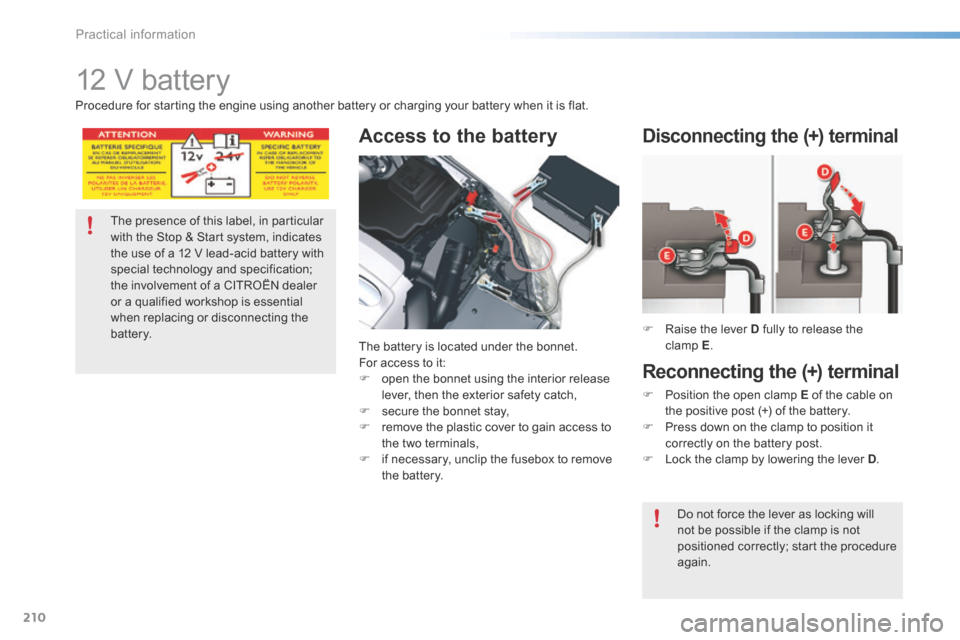
210
12 V battery
Access to the battery
The battery is located under the bonnet.
For access to it:
F open the bonnet using the interior release
lever, then the exterior safety catch,
F secure the bonnet stay,
F remove the plastic cover to gain access to
the two terminals,
F if necessary, unclip the fusebox to remove
the battery. F
Raise the lever D fully to release the
clamp E .
Disconnecting the (+) terminal
The presence of this label, in particular
with the Stop & Start system, indicates
the use of a 12 V lead-acid battery with
special technology and specification;
the involvement of a CITROËN dealer
or a qualified workshop is essential
when replacing or disconnecting the
battery.
Procedure for starting the engine using another battery or charging your battery when it is flat.
Reconnecting the (+) terminal
F
Position the open clamp E of the cable on
the positive post (+) of the battery.
F Press down on the clamp to position it
correctly on the battery post.
F Lock the clamp by lowering the lever D .
Do not force the lever as locking will
not be possible if the clamp is not
positioned correctly; start the procedure
again.
Practical information
Page 213 of 362
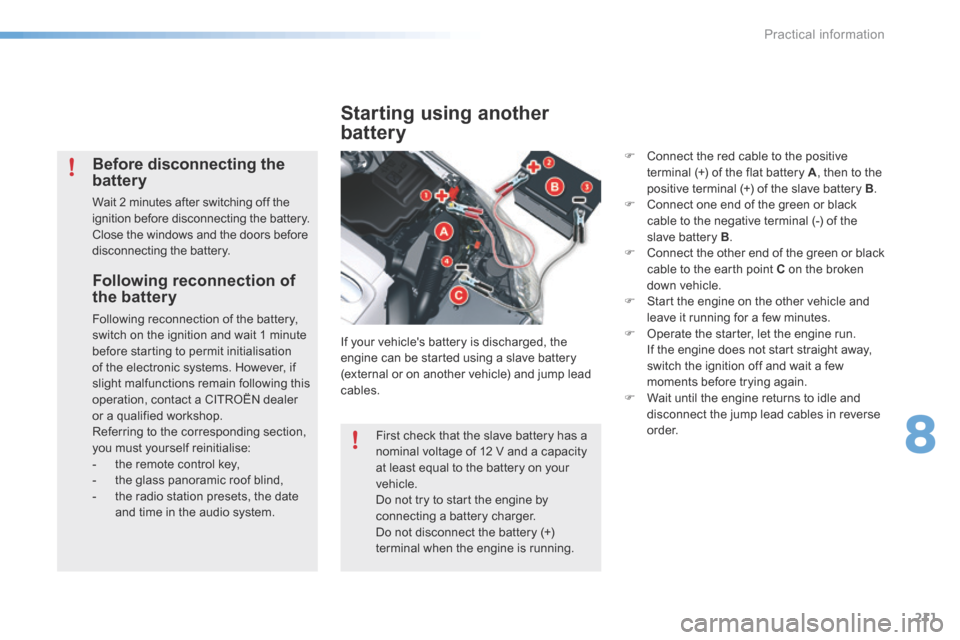
211
Following reconnection of
the battery
Following reconnection of the battery,
switch on the ignition and wait 1 minute
before starting to permit initialisation
of the electronic systems. However, if
slight malfunctions remain following this
operation, contact a CITROËN dealer
or a qualified workshop.
Referring to the corresponding section,
you must yourself reinitialise:
- the remote control key,
- the glass panoramic roof blind,
- the radio station presets, the date
and time in the audio system.
Starting using another
battery
If your vehicle's battery is discharged, the
engine can be started using a slave battery
(external or on another vehicle) and jump lead
cables.
Before disconnecting the
battery
Wait 2 minutes after switching off the
ignition before disconnecting the battery.
Close the windows and the doors before
disconnecting the battery. F
Connect the red cable to the positive
terminal (+) of the flat battery A , then to the
positive terminal (+) of the slave battery B .
F Connect one end of the green or black
cable to the negative terminal (-) of the
slave battery B .
F Connect the other end of the green or black
cable to the earth point C on the broken
down vehicle.
F Start the engine on the other vehicle and
leave it running for a few minutes.
F Operate the starter, let the engine run.
If the engine does not start straight away,
switch the ignition off and wait a few
moments before trying again.
F Wait until the engine returns to idle and
disconnect the jump lead cables in reverse
o r d e r.
First check that the slave battery has a
nominal voltage of 12 V and a capacity
at least equal to the battery on your
vehicle.
Do not try to start the engine by
connecting a battery charger.
Do not disconnect the battery (+)
terminal when the engine is running.
8
Practical information
Page 214 of 362
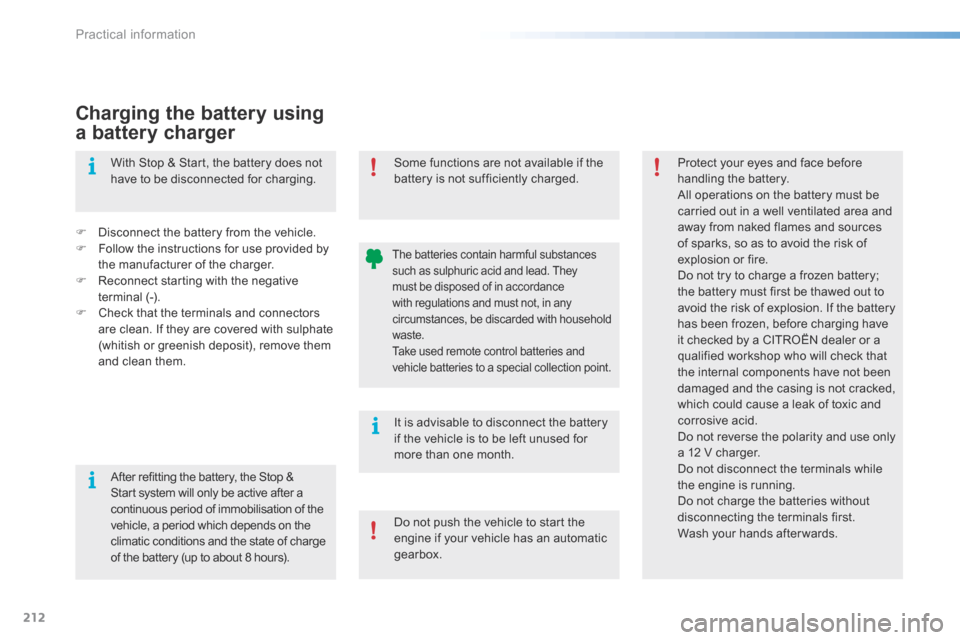
212
Charging the battery using
a battery charger
F Disconnect the battery from the vehicle.
F Follow the instructions for use provided by
the manufacturer of the charger.
F Reconnect starting with the negative
terminal (-).
F Check that the terminals and connectors
are clean. If they are covered with sulphate
(whitish or greenish deposit), remove them
and clean them.With Stop & Start, the battery does not
have to be disconnected for charging.
Some functions are not available if the
battery is not sufficiently charged.
Protect your eyes and face before
handling the battery.
All operations on the battery must be
carried out in a well ventilated area and
away from naked flames and sources
of sparks, so as to avoid the risk of
explosion or fire.
Do not try to charge a frozen battery;
the battery must first be thawed out to
avoid the risk of explosion. If the battery
has been frozen, before charging have
it checked by a CITROËN dealer or a
qualified workshop who will check that
the internal components have not been
damaged and the casing is not cracked,
which could cause a leak of toxic and
corrosive acid.
Do not reverse the polarity and use only
a 12 V charger.
Do not disconnect the terminals while
the engine is running.
Do not charge the batteries without
disconnecting the terminals first.
Wash your hands after wards.
It is advisable to disconnect the battery
if the vehicle is to be left unused for
more than one month.
The batteries contain harmful substances
such as sulphuric acid and lead. They
must be disposed of in accordance
with regulations and must not, in any
circumstances, be discarded with household
waste.
Take used remote control batteries and
vehicle batteries to a special collection point.
d
o not push the vehicle to start the
engine if your vehicle has an automatic
gearbox.
After refitting the battery, the Stop &
Start system will only be active after a
continuous period of immobilisation of the
vehicle, a period which depends on the
climatic conditions and the state of charge
of the battery (up to about 8 hours).
Practical information
Page 215 of 362
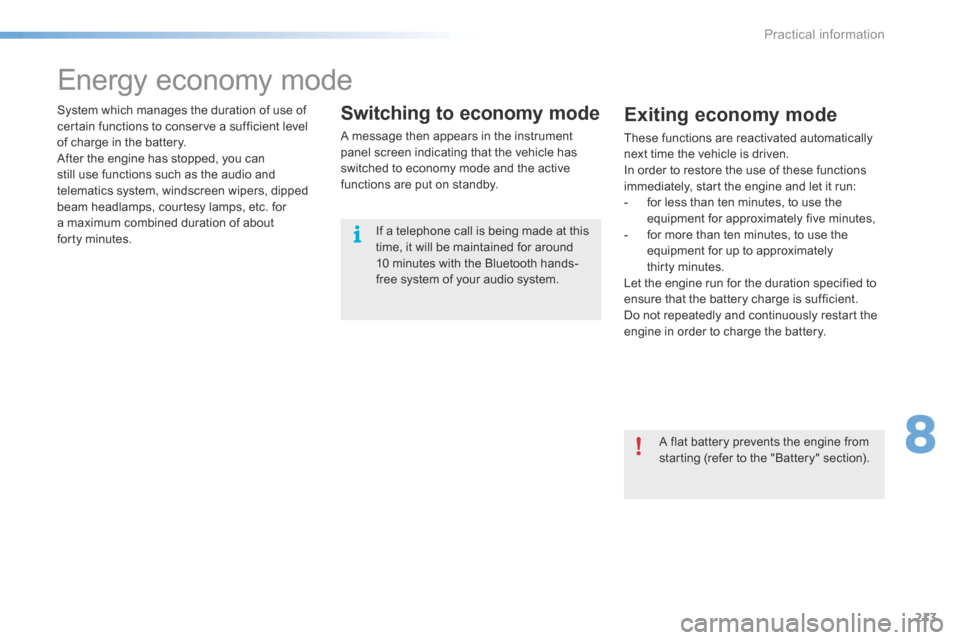
213
Energy economy mode
System which manages the duration of use of
certain functions to conserve a sufficient level
of charge in the battery.
After the engine has stopped, you can
still use functions such as the audio and
telematics system, windscreen wipers, dipped
beam headlamps, courtesy lamps, etc. for
a maximum combined duration of about
forty minutes.Switching to economy mode
A message then appears in the instrument
panel screen indicating that the vehicle has
switched to economy mode and the active
functions are put on standby.
If a telephone call is being made at this
time, it will be maintained for around
10 minutes with the Bluetooth hands-
free system of your audio system.
Exiting economy mode
These functions are reactivated automatically
next time the vehicle is driven.
In order to restore the use of these functions
immediately, start the engine and let it run:
- for less than ten minutes, to use the
equipment for approximately five minutes,
- for more than ten minutes, to use the
equipment for up to approximately
thirty minutes.
Let the engine run for the duration specified to
ensure that the battery charge is sufficient.
Do not repeatedly and continuously restart the
engine in order to charge the battery.
A flat battery prevents the engine from
starting (refer to the "Battery" section).
8
Practical information
Page 216 of 362
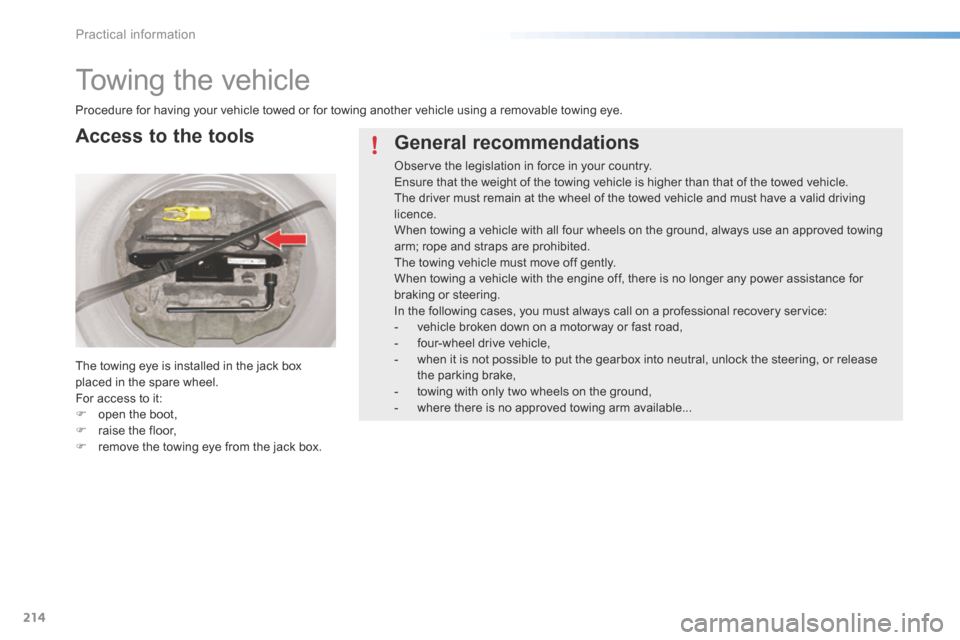
214
Towing the vehicle
Procedure for having your vehicle towed or for towing another vehicle using a removable towing eye.
The towing eye is installed in the jack box
placed in the spare wheel.
For access to it:
F open the boot,
F raise the floor,
F remove the towing eye from the jack box.
Access to the tools
General recommendations
Observe the legislation in force in your country.
Ensure that the weight of the towing vehicle is higher than that of the towed vehicle.
The driver must remain at the wheel of the towed vehicle and must have a valid driving
licence.
When towing a vehicle with all four wheels on the ground, always use an approved towing
arm; rope and straps are prohibited.
The towing vehicle must move off gently.
When towing a vehicle with the engine off, there is no longer any power assistance for
braking or steering.
In the following cases, you must always call on a professional recovery service:
- vehicle broken down on a motor way or fast road,
- four-wheel drive vehicle,
- when it is not possible to put the gearbox into neutral, unlock the steering, or release
the parking brake,
- towing with only two wheels on the ground,
- where there is no approved towing arm available...
Practical information
Page 217 of 362

215
F On the front bumper, unclip the cover by
levering at the bottom with the flat end of
the towing eye.
F Screw the towing eye in fully.
F Attach a towing arm.
F Switch on the hazard warning lamps on
both vehicles.
Towing your vehicle
Failure to observe this recommendation
could result in damage to certain
braking components and the absence
of braking assistance the next time the
engine is started.
In the event of a problem or malfunction
with the automatic gearbox, the vehicle
may be immobilised with a gear
engaged. In this case the front of the
vehicle must be lifted for towing. F
On the rear bumper, unclip the cover:
● by pressing at the bottom,
● then by levering at the top using the flat
end of the towing eye.
F Screw the towing eye in fully.
F Attach a towing arm.
F Switch on the hazard warning lamps on
both vehicles.
Towing another vehicle
F Place the gear lever in neutral (position N
with an automatic gearbox).
8
Practical information
Page 218 of 362
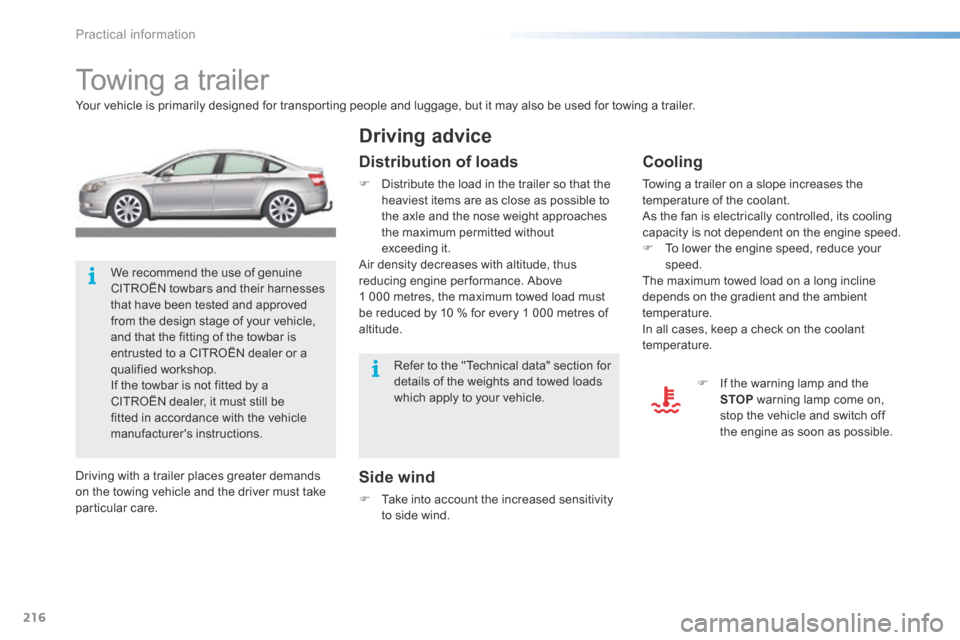
216
Towing a trailer
Your vehicle is primarily designed for transporting people and luggage, but it may also be used for towing a trailer.
Side wind
F Take into account the increased sensitivity
to side wind.
Driving advice
Cooling
Towing a trailer on a slope increases the
temperature of the coolant.
As the fan is electrically controlled, its cooling
capacity is not dependent on the engine speed.
F To lower the engine speed, reduce your
speed.
The maximum towed load on a long incline
depends on the gradient and the ambient
temperature.
In all cases, keep a check on the coolant
temperature.
We recommend the use of genuine
CITROËN towbars and their harnesses
that have been tested and approved
from the design stage of your vehicle,
and that the fitting of the towbar is
entrusted to a CITROËN dealer or a
qualified workshop.
If the towbar is not fitted by a
CITROËN dealer, it must still be
fitted in accordance with the vehicle
manufacturer's instructions.
Driving with a trailer places greater demands
on the towing vehicle and the driver must take
particular care.
Distribution of loads
F Distribute the load in the trailer so that the
heaviest items are as close as possible to
the axle and the nose weight approaches
the maximum permitted without
exceeding it.
Air density decreases with altitude, thus
reducing engine per formance. Above
1 000 metres, the maximum towed load must
be reduced by 10 % for every 1 000 metres of
altitude.
F If the warning lamp and the
STOP warning lamp come on,
stop the vehicle and switch off
the engine as soon as possible.
Refer to the "Technical data" section for
details of the weights and towed loads
which apply to your vehicle.
Practical information
Page 219 of 362
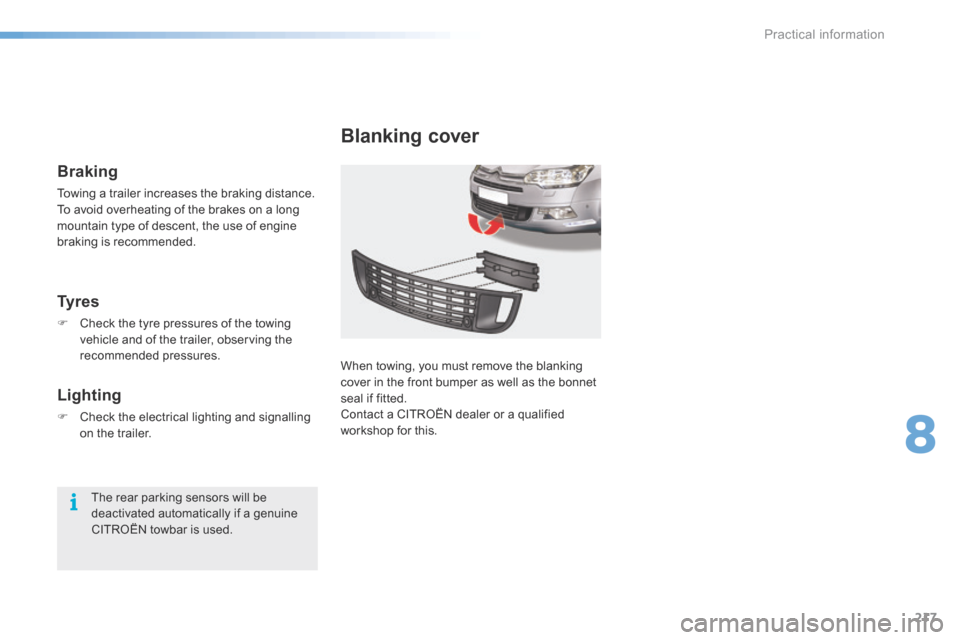
217
Blanking cover
When towing, you must remove the blanking
cover in the front bumper as well as the bonnet
seal if fitted.
Contact a CITROËN dealer or a qualified
workshop for this.
Ty r e s
F Check the tyre pressures of the towing
vehicle and of the trailer, observing the
recommended pressures.
Lighting
F Check the electrical lighting and signalling
on the trailer.
The rear parking sensors will be
deactivated automatically if a genuine
CITROËN towbar is used.
Braking
Towing a trailer increases the braking distance.
To avoid overheating of the brakes on a long
mountain type of descent, the use of engine
braking is recommended.
8
Practical information
Page 220 of 362

218
Roof bars
The design of your vehicle requires the use
of roof bars that are tested and approved by
CITROËN, for your safety and to avoid damage
to the roof and tailgate.
Regardless of the type of loading equipment
to be transported on the roof (bicycle carrier,
ski carrier...), it is imperative that you add
transverse roof bars. Any securing or lashing to
components other than the roof bars is strictly
prohibited.
Recommendations
F Distribute your load evenly, avoiding
overloading on one side.
F Arrange the heaviest part of the load as
close as possible to the roof.
F Anchor the load securely and draw
attention to it if any part of it is
overhanging.
F Drive gently, as the vehicle will be more
liable to the effects of side winds (vehicle
stability may be altered).
F Remove the roof bars as soon as they are
no longer needed. Maximum load that can be distributed
on the roof bars (for a loading height
not exceeding 40 cm; except bicycle
carrier): 80 kg.
If the height exceeds 40 cm, adapt your
speed to the profile of the road to avoid
damaging the roof bars and the fixings
on the roof.
Please refer to national legislation in
order to comply with the regulations
concerning the transportation of objects
which are longer than the vehicle.
Practical information